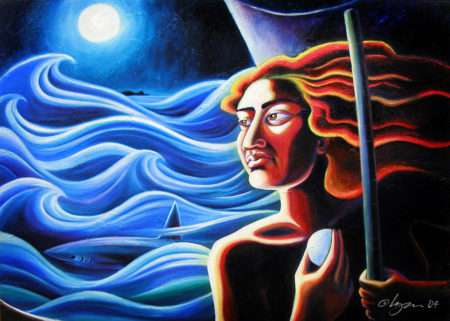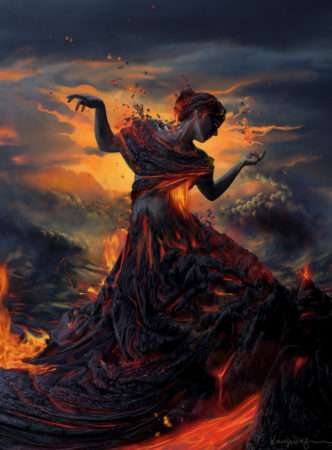 |
Canku Ota
|
 |
|
(Many Paths)
|
||
|
An Online Newsletter
Celebrating Native America
|
||
|
June 2018 - Volume 16
Number 6
|
||
|
|
||
|
Pele, Goddess Of
Fire
|
||
|
by Lady Gryphon
|
||
Pele the Fire Goddess – Pronounced peh-leh or pel-l? – is one of the most well known and revered in Hawaiian mythology. As a sign of respect you may hear her referred to as Madame Pele or Tutu Pele. She is a goddess of fire, lightning, dance, wind, volcanoes and violence. Her poetic name is Ka wahine `ai honua or the woman who devours the land. She is both a creator and destroyer. She throws molten fountains into the air and governs the great flows of lava. With her power over the volcanoes, she created the Hawaiian Islands and to this day, she has been known to reveal herself throughout the beautiful islands she crafted herself. No Kahiki mai ka wahine `o Pele, Translation: According to legend, Pele lives in one of the most active volcanoes in the world. She calls the summit of Kilauea volcano, in Halema?uma?u crater home. Although, her reach is throughout Hawaii nei. Goddess Pele Origins The Hawaiian (Polynesian) goddess of the volcano, she was born in Honua-Mea, part of Tahiti. One of a family of six daughters and seven sons born to Haumea (a very ancient Earth goddess) and Kane Milohai (creator of the sky, earth and upper heavens). There are a number of variations in the legends that tell of how Pele first came to the Hawaiian Islands. One of the most common relates that she was exiled by her father because of her temper. The final straw being a fighting with her elder water-goddess sister Na-maka-o-Kaha’i, whose husband Pele had seduced. Pele’s oldest brother, the king of the sharks, Kamohoali’i, gave her a great canoe, upon which she and her brothers traveled far from home, over the wide expanse of the seas, sailing on this great canoe eventually to find Hawaii. All the while, Pele battles with her sister Namakaokahai who is a Sea Goddess. During this perilous journey she carried her favorite little sister, Hi’iaka (or Hi’iaka i ka poli o Pele – Hi’iaka in the bosom of Pele) in egg-form all the way to the Hawaiian islands. That makes Hi’iaka the first God of the Pele family to be born in Hawaii.
The Creation of Hawaii When Pele got to Hawaii, she first used her Pa’oa, or o’o stick on Kauai — striking deep into the earth but she was attacked by her older sister and left for dead. She was able to recover and flee to Oahu, where she dug several “fire pits,” including the crater we now called Diamond Head, in Honolulu. After that, she left her mark on the island of Molokai before traveling further southeast to Maui and creating the Haleakala Volcano. By then her older sister Namakaokahai, realized Pele was still alive and she went to Maui to do battle. Finally, the epic battle ended near Hana, Maui, where Pele was torn apart by her sister. Legend says her bones remain as a hill called Ka-iwi-o-Pele. Upon death, she became a god and found a home on Mauna Loa, on the Island of Hawai’i. There she dug her final and eternal fire pit, Halemaumau Crater, at the summit of Kilauea Volcano. Known as the Navel of the World, Ka Piko o ka Honua — were the gods began creation. She is said to live there to this day and is thought to be very happy there. |
||||
|
|
|
|
||
|
|
||
| Canku Ota is a free Newsletter celebrating Native America, its traditions and accomplishments . We do not provide subscriber or visitor names to anyone. Some articles presented in Canku Ota may contain copyright material. We have received appropriate permissions for republishing any articles. Material appearing here is distributed without profit or monetary gain to those who have expressed an interest. This is in accordance with Title 17 U.S.C. Section 107. | ||
|
Canku Ota is a copyright ©
2000 - 2018 of Vicki Williams Barry and Paul Barry.
|
||
 |
 |
|
|
The "Canku
Ota - A Newsletter Celebrating Native America" web site and
its design is the
|
||
|
Copyright ©
1999 - 2018 of Paul C. Barry.
|
||
|
All Rights Reserved.
|
||

